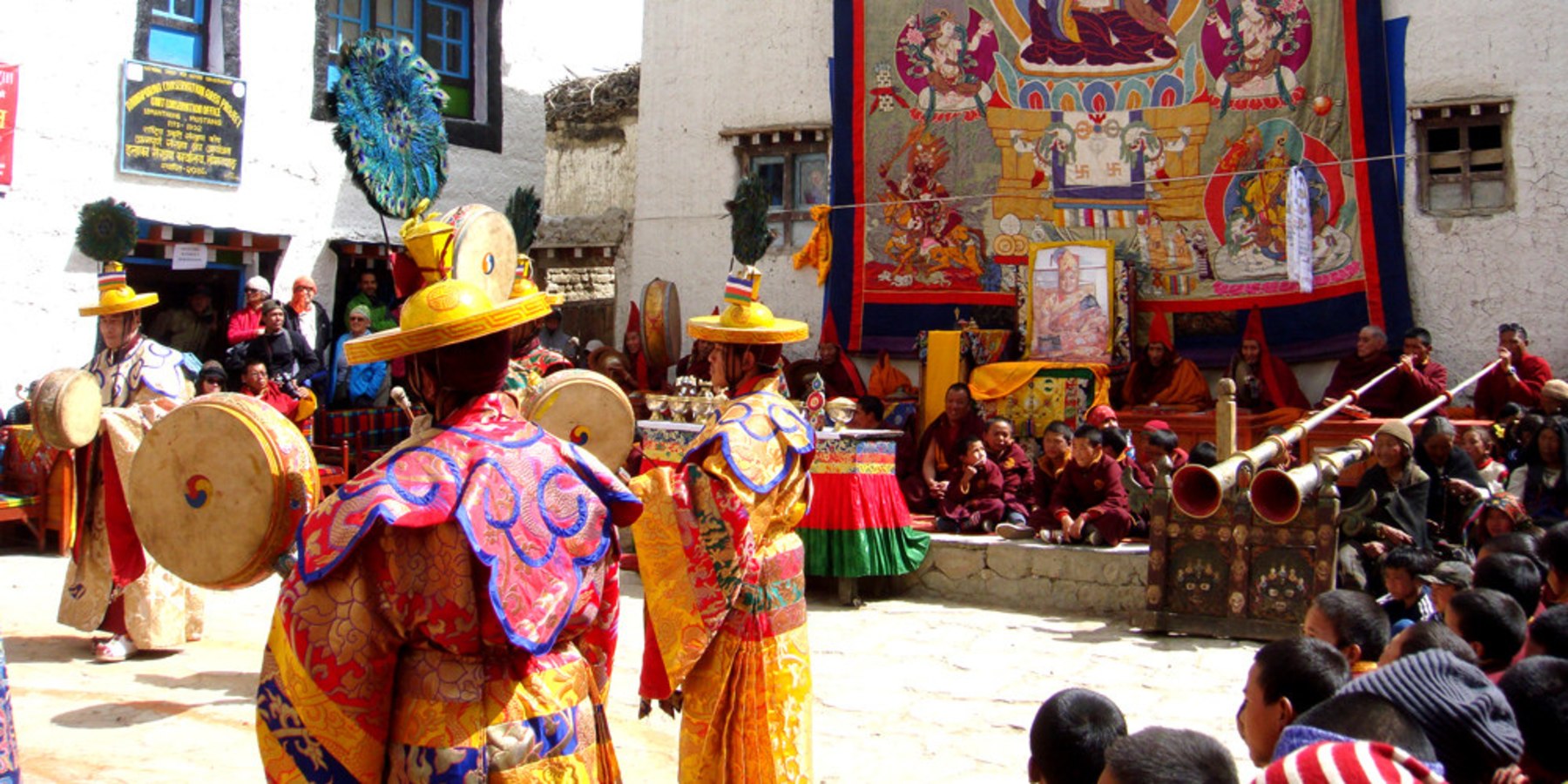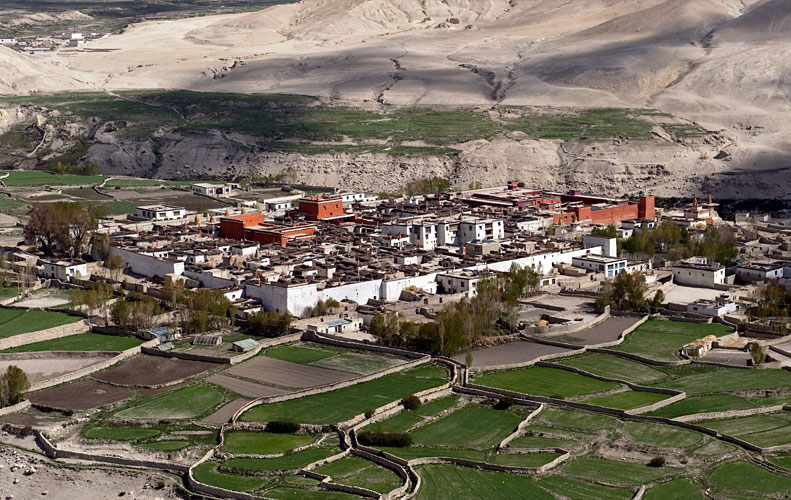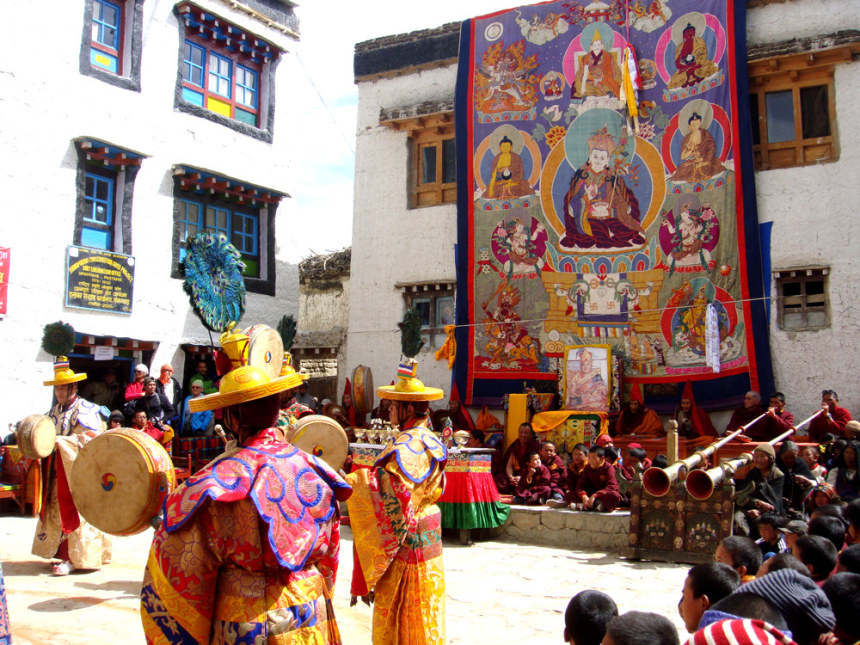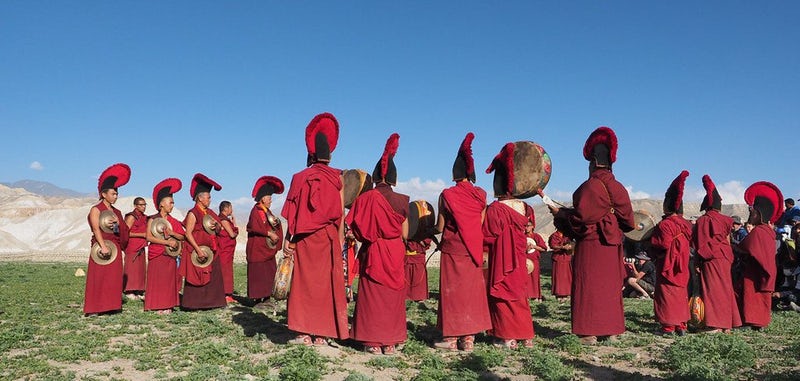
Our 14 member team including foreigner guests, guide, luggage carriers and me as assistant guide departs from Kathmandu for Upper Mustang trek to attend the special occasion of Tiji Festival. We choose road trip from Kathmandu to Pokhara, from Pokhara we took a flight to Jomsom and then we started our trek from Jomsom. In total, we spend 7 days to reach Lo-Manthang which was our final destination for the festival. This trek takes us to the once hidden kingdom of Lo and offers us a once in a lifetime opportunity to witness the ancient and colourful festival of Tiji. We can also travel to Lo-Manthang by off-road jeep drive or by helicopter which are the only possible medium of transportation to reach Lo-Manthang quickly but remember that we will miss many of the ancient & interesting monasteries, villages and beautiful landscape of this region.
The Mustang region lies north of the main Himalayan range in the area known as the Trans-Himalaya, which is locally known as Lo is only opened to the trekkers of foreign lands in March 1992. The Tibetan influenced area north of Kagbeni is known as Upper Mustang. The capital of Upper Mustang Lo-Manthang is also home to Mustang’s former Late King Jigme Dorjee Palbar Bista who lost his royal title in 2008 after Nepal became a republic, but he is still highly regarded and respected by the locals. His family still occupies the royal palace situated at the center of the city square. A vast high valley, arid and dry, it has a barren desert-like appearance similar to the Tibetan Plateau and is characterized by eroded canyons and colourful stratified rock formations. Mustang was once an important route for crossing the Himalaya between Tibet and Nepal, and many of the old salt caravans passed through Mustang. We can explore the wonders of the architecture, language, culture and traditions which are almost purely Tibetan after we trek in this hidden kingdom.
Once we reach the capital city of the Mustang Kingdom i.e. “Lo-Manthang”, we got to see the walled city in a broad valley filled with fields, horses and yaks, the roof of the houses filled with woods and prayers flags, monasteries with red colour paintings and Tibetan faced people with distinct culture and traditions. Once we enter the walled city, we got the opportunity to see spectacular structures featuring traditional Buddhist paintings, woodcarvings and massive Buddha sculptures and monasteries. The local monastery here serves as one of the only centres of education in Mustang. This is a very well run institution that is striving to preserve the traditional teachings of this small kingdom.
We have timed our trip to coincide with the annual Tiji Festival here in the capital city. This is said to be one of the last great traditional festivals in the Himalaya to experience for. Due to the reason of the festival, when we reach there all the hotels were packed, the streets were full of people from different part of the planet, local people seem busy doing their business. We were arranging a home-stay program in the city for our 5 days stays, which is the best way to learn about the local foods, cultures and traditions of Upper Mustang. We also fixed our tents to make our stay comfortable and all our group members were super excited for the festival which is going to start the next day.
ABOUT TIJI FESTIVAL
The most sacred and colourful festivals in the whole region held at the walled city of Lo-Manthang features a three-day ritual known as the ‘Chasing of Demons’. Monks donning masks and colourful costumes enact the story of a deity named Dorje Jono who fought against his demon father to save the Kingdom of Mustang from falling apart. According to the Tiji myth, the demon father wreaked havoc on Mustang by bringing a shortage of water (a highly precious resource in this very dry land) and causing many resulting disasters from famine to animal loss. Dorje Jono eventually beats the demon and banishes him from the land. Tiji is a celebration and reaffirmation of this myth and throughout the festival, the various scenes of the myth will be enacted. It is, of course, timed to coincide with the end of the dry winter/spring season and will usher in the wetter monsoon season (the growing season of Mustang). Tiji comes from the word “ten che” meaning ‘the hope of Buddha Dharma prevailing in all worlds’ and is effectively a spring renewal festival. The festival is held annually at the onset of the spring season. As spring season symbolizes regeneration of life, this festival is also about hope, revival and affirmation of life. We found ourselves in the midst of a festival in which over a hundred men, women and children were taking part.
Before us, a spread a sea of weather-beaten brown faces that contrasted with those of the beaming, dirty little children who clung like grapes upon the rooftops of the houses. The women looked superb in hand-woven sleeveless chuba’s (a bat-robe style dress made of thick wool) over bright, loose silk blouses. Around their waistbands were tucked two aprons, a short one that hung down in front, the other caught in the belt and hanging down behind to the ground. These were gaily striped in bright narrow bands of blue, red, green and yellow. Many women were literally smothered with ornaments of silver and precious stones; necklaces of bright orange corralling stones altering with turquoises, ivory white bracelets made of a truncated conch shell and headdress studded with turquoises ran along the central parting of their hair and fell down their backs.
Michel Peissel was the first westerners to witness the Tiji festival in 1964 during a visit to Mustang by special permission of the Government of Nepal. He was also third westerners to ever visit Mustang at that time. He arrived at Lo-Manthang only in the last day to witness festival and later wrote: “The scenes I witnessed were so extraordinary and so unexpected that I dared not to believe my eyes and even today I have some trouble in believing in the reality of what I saw that day.”
Peter Matheissan wrote the following account of the three-day festival:
Day One of Tiji
The Tiji ceremony began on the 29th of May in the main squire east of the palace, under snapping prayer flags, white cracked walls, and blue-framed windows. Early in the afternoon, horns resounded - the shorthorn or kagyling, which announces the two twelve-foot copper dunchens with their elephantine blaring, followed by two double-reeded horns (the player is trained to blow with a peculiar technique of double-breathing), all accompanied by drum and cymbals.
Next, an ancient and enormous tanka three stories high was unrolled down to the entire south wall of the square. The tanka portrayed Padma Sambhava (or “Guru Rimpoche”) who brought this ceremony to Tibet in the 8th century (it said to have originated in Afghanisthan) and founded the Nyingma sect of Tibetan Buddhism. Following incense purification, Crown Prince Jigme in a black fur hat, black leather boots and a tailored traditional dress made an offering of six brass bowls of grain set out on a wooden altar with the painted cakes made from butter and flour. At mid-afternoon, in high wind and blowing dust, eleven lamas in maroon and gold, wearing high red hats came from the palace and took their places along the wall beneath the tanka, with Tashi Tenzing on the elevated seat just in the center. At one end of the line, big Ri-Dorje and an older monk commence a sonorous overture on the twelve-foot horns, which are supported at the open end by a carved wood stand. Horns and drums are accompanied by cymbals struck more or less casually by all the lamas. As the monks and lamas commence chanting, twelve more monks come from the palace in maroon and royal blue and glittering gold brocade, with cymbal-shaped hats decked with upright peacock plumes. Soon they withdraw, to be replaced by the masked dancers who start the portrayal of the Tiji myth.
Dorje Jono repels the demon through the power of his magical dancing; he dances fifty-two separate dances, one of them in ten different bodies, each with a different head in the course of which he finds time to poke fun at the clownish figures of Hindu yogi and a Chinese Chan (Zen) master. As the dances end, Dorje Jono kills the demon after which his people are relieved of their plague of misfortunes, water becomes plentiful once more and balance & harmony of existence are restored.
Day Two of Tiji
For the second day of Tiji, numbers of Loba have arrived from the outlying hamlets and the small square is thronged with wild beautiful people with all of the women and children, at least in traditional dress. On the south wall, the great ancient tanka has been replaced by another no less than a century old, a tapestry of fine silk brocade, embroidered in Tibet in the last days of the old regime and brought by the raja's father from Lasha. Eventually, the raja appears in turquoise-green wool boots and regal purple robe and Rani Sahib, also in purple, wears a whole crown of tiny river pearls set off by dozens of large red coralline stones interspersed with matched ornaments of turquoise. The Crown Prince, too, wears purple, as well as a shirt of fire-gold over neat western trousers and black leather boots. All are attended by royal relatives and nobles, the men in peaked hats of gold brocade the women in imperial displays of turquoise and silver.
Fortunately, we outsiders are very few, all but lost in the horde of undefended merry faces. The costumes and masks, the twelve-foot horns, the gold cups of wheat, the butter cakes, the snow peaks and wind, dust and sun, the mehti, snow leopard, snow pigeons, saligrams, the dying glacier and the desert ruins, the drunks and rajas and foreigners, the dogs and yaks. Tantra! The rite to a cloth doll (representing the demon who symbolically being cast out) perhaps two feet long. Into this figure was thrust in an interminable ceremony a series of blue daggers, until just at dark, the demon’s pitiful remains were borne away into the palace, and the line of cold wind-swept lamas under the huge tanka become free to leave.
Day Three of Tiji
On the third day, Tiji ends with the ceremonial destruction of the evil remains, represented by some long black yak hair and red torma cakes minced to a dark red furry. The remains are chanted over by lama, as his assistant burn juniper and frankincense and two lines of monks strike hand drums while those against the wall blow horns. Eventually, a procession forms, led by three banners, red and white, then the bearers of five braziers bearing the demon’s remains, then the horn blowers and monks, then lamas, then court musicians, then the raja and the crown prince and their attendants. The procession pauses for chanting and ceremony at the chortens outside of the main gate, then repeats the ceremonials at the grain-threshing platforms east of the walls, arriving finally at the edge of the town fields. The demons red remnants are set out on an old tiger skin, whereupon they are attacked by bow and arrow, slings and the old guns. One by one, the braziers filled with the poor devils remains are overturned upon the ground, each time to a wild cannonade from the old muzzle-loaders and a wave of cheers and smoke. Finally, the emptied braziers are removed and the sad remains flailed with the tiger skin to satisfy the crowd that nothing has been overlooked in dispelling the forces of evil from Lo-Manthang. Tiji is over, and the next day the people will go home to their own villages.




